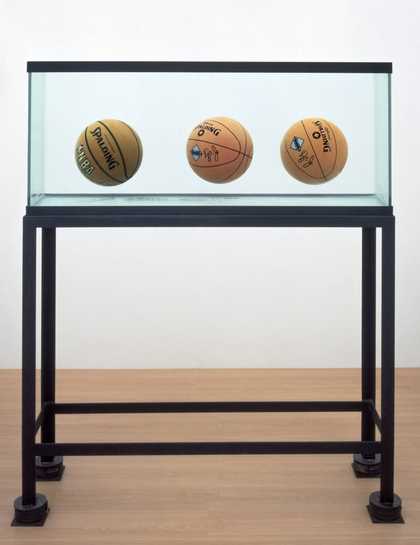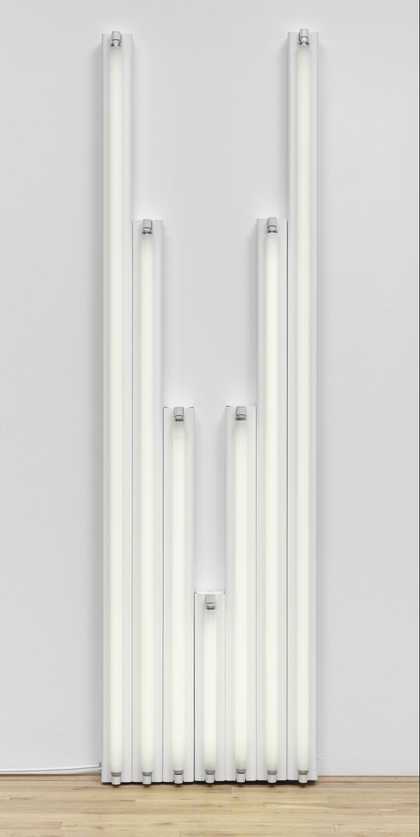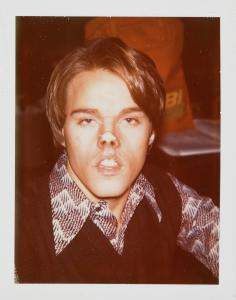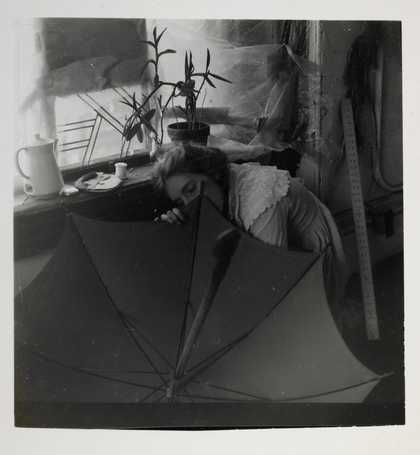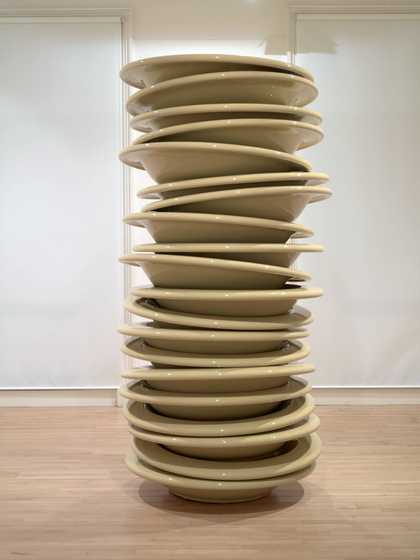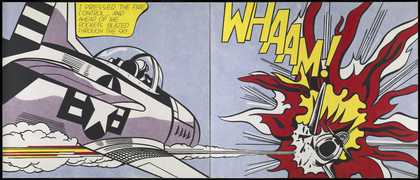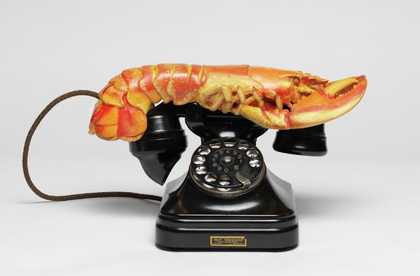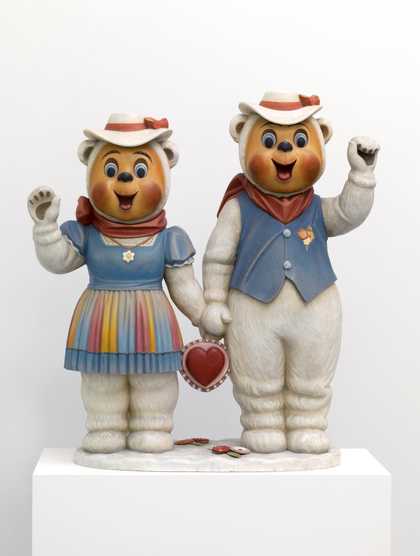
Jeff Koons
Winter Bears (1988)
ARTIST ROOMS Tate and National Galleries of Scotland
Introduction
Oversized ornaments, children’s toys and celebrities have all featured in the art of Jeff Koons. He uses these unlikely subjects to poke fun at comfortable suburban lives and tastes, and criticise a contemporary culture driven by commerce. He has also antagonised the art world by placing adverts in magazines questioning its judgements and authority on what is good and bad art.
Using key artworks in the ARTIST ROOMS collection this resource takes an in-depth look at the work of Jeff Koons.
artist and showman
Jeff Koons developed a talent for drawing and painting at a young age. His father, an interior designer and decorator, exhibited his son’s work in the showroom of his decorating business. This early understanding of the role that commerce plays in art, as well as the importance of self-promotion, can be seen throughout Jeff Koons’s career.
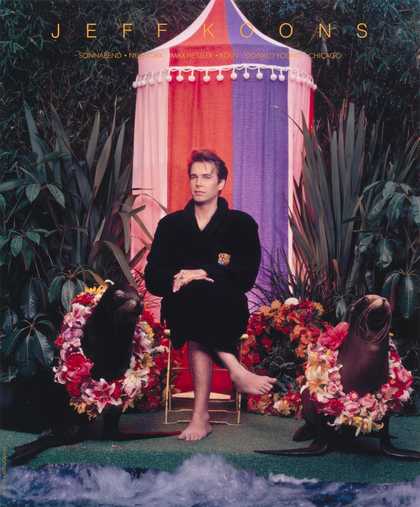
Jeff Koons
Art Magazine Ads (Arts) (1988–9)
ARTIST ROOMS Tate and National Galleries of Scotland
After graduating from art school in Baltimore in 1976, Jeff Koons moved to New York. He began working at the membership desk of the MoMA (Museum of Modern Art, New York) and quickly became known for his impressive salesmanship. He then began a career as a commodities trader on Wall Street to fund his art practice. (A commodities broker is a trader who buys and sells things such as foodstuffs, energy, metals and currencies to make a profit for his clients.)
His first success in the art world came in the 1980s. The 1980s are often referred to as ‘the decade of greed’. Koons’s exploration of themes such as commerce, mortality and inequalities within contemporary society can perhaps be seen as a response to this 80s spirit of decadence and moral decline.
Art Movements
Jeff Koons has been associated with pop art, conceptual art and minimalism.
His use of themes and subjects from popular culture (such as toys, ornaments and advertising) is characteristic of pop art. But Koons’s work also has qualities that suggest minimalist art. He uses modern materials and his works show little obvious personal expression. His orderly, grid-like display of objects in his series The New also suggests minimalism. Though Koons himself said:
I have always placed order in my work not out of respect for minimalism, but to give the viewer a sense economic security.
Koons often uses ordinary everyday objects – such as vacuum cleaners and basketballs – in his art. In doing this he carries on a tradition first used by artist Marcel Duchamp in the early twentieth century. Duchamp is often referred to as the father of conceptual art. Duchamp chose objects including a bottle rack, a shovel and a urinal and called them readymade artworks, describing his selection of these objects as a creative act. By ignoring the object’s ‘useful’ function and presenting it as an artwork with a title in a gallery, Duchamp gave the objects a new meaning.
The New
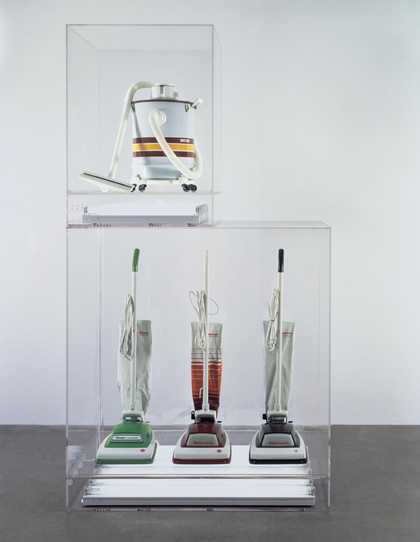
Jeff Koons
New Hoover Convertibles, Green, Red, Brown, New Shelton Wet/Dry 10 Gallon Displaced Doubledecker (1981–7)
ARTIST ROOMS Tate and National Galleries of Scotland
If one of my works was to be turned on, it would be destroyed.
Jeff Koons
In 1980 Jeff Koons exhibited a series of sculptures called The New at the New Museum of Contemporary Art on New York. The sculptures consisted of vacuum cleaners displayed in clear plastic boxes and lit by fluorescent lights.
By taking a mass-produced, everyday object associated with domestic, suburban life and presenting it as art he raised its status from the ordinary to the iconic. The sculptures explore the way fantasies and desires can be transferred on to everyday objects. At the time that this sculpture was created, the American company Hoover dominated the carpet cleaning industry. By using this well-known brand for his sculpture and including its name in the work’s title he highlights commerce and success. The vacuum cleaners, like much of Koons work, also suggest comparisons with the human body. They look a little like people standing in a neat row.
They’re being displayed just for their integrity of birth – that they’re not used, they’re not functioning, they’re not collecting dirt, but they’re just displaying their integrity of birth. It was to also make a play with aspects of the eternal and an ultimate kind of state of being.
Koons's vacuum cleaner sculptures can be described as readymades.
Have a Go: Create a Readymade Artwork
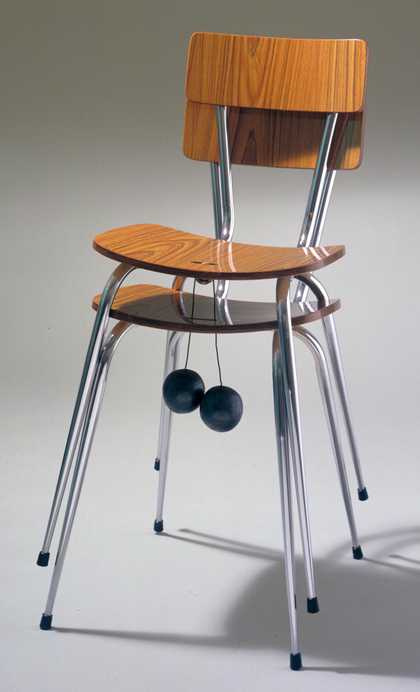
Richard Wentworth
Siege (1983–4)
Tate
Create your own readymade using an everyday object. It might help to have a look at more readymade artworks in Tate's collection.
- Choose an everyday object from around your home. It can be anything – from something you use in your kitchen to something you wear.
- Think about whether the object has any significance for you and if that matters. Think about ways you could present the object to remove it from its function (what it is used for) and make it appear like art.
Equilibrium
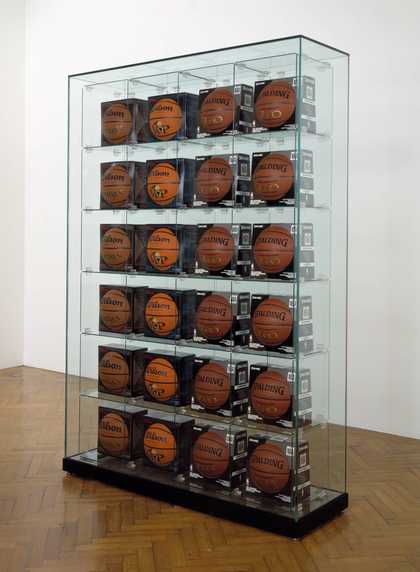
Jeff Koons
Encased - Four Rows (1983–93)
ARTIST ROOMS Tate and National Galleries of Scotland
I want to have an impact in people’s lives. I want to communicate to as many people as possible. And the way to communicate with the public right now is through TV and advertising. The art world is not effective right now.
Jeff Koons
Jeff Koons continued to use readymades in his Equilibrium series of artworks created between 1983 and1993. The series brings together art, commerce and sport. Koons wanted to reveal how consumer products communicate cultural values. He also wanted to reflect the insecurity surrounding social status and social mobility – the opportunities that people have, to make a better life for themselves.
Like the vacuum cleaners, the basketballs in Four Rows 1983–93 are presented as if they are on display in a shop. They are packaged in their original boxes and shown in a glass case. This removes the basketballs from what they were made for – playing sport. Presented within glass cases (or vitrines), the basketballs become precious objects. They look a little like religious relics, something to be worshipped. Koons also explores the idea of mortality – or death – in these artworks. Sealed within the glass cases the balls are not capable of movement, they appear lifeless.
Other works in the series include cases containing basketballs suspended in liquid, such as Three Ball Total Equilibrium Tank (Two Dr J Silver Series, Spalding NBA Tip-Off) 1985, and advertisements featuring basketball stars encouraging consumers to buy Nike products. These suggest the players’ success is indebted to the brand, and also perhaps that success can be bought.
Seen together, the pieces captured the aspirations of young working-class Americans who want to find fame and wealth through sport. The title of the series Equilibrium could be seen to refer to the social equilibrium created by sport, as well as the more literal reference of the balancing of the basketballs. The word 'equilibrium' also means things remaining the same or unchanged. So Koons might also be suggesting that despite working-class aspirations being pursued through sport, nothing much changes.
Equilibrium dealt with states of being that really don’t exist, like a fish tank with a ball hovering in equilibrium, half in and half out of the water. This ultimate or desired state is not sustainable – eventually the ball will sink to the bottom of the tank. Then there were Nike posters, which acted as sirens that could take you under. I looked at at the athletes in those posters as representing the artists of the moment, and the idea that we were using art for social mobility the way other ethnic groups have used sports. We were middle-class white kids using art to move up into another social class.
Jeff Koons
The repetition and references to commercial packaging and youth culture suggest the ideas and visual imagery of pop art. But the sculptures, with their formal grid-like arrangement, also refer to minimal art.
Banality

Jeff Koons
Art Magazine Ads (Art in America) (1988–9)
ARTIST ROOMS Tate and National Galleries of Scotland
The artworks that Jeff Koons is best known for belong to his Banality series. This series, from 1988, is a celebration of popular culture and the banal. (The word banal describes things that are unoriginal, obvious and boring.) Koons's Banality series includes artworks made from ceramics, porcelain and painted wood. The themes are drawn from images and icons in popular culture and often feature animals. For example Michael Jackson and Bubbles 1988 shows pop star Michael Jackson with his pet chimpanzee.
To make his Banality sculptures, Koons used the type of fine materials and crafts that appeal to middle class tastes. However the subjects he chose were popular or kitsch. Winter Bears 1988, looks like the sort of cheap souvenir that someone might bring back from an Alpine holiday. But Koons commissioned skilled woodworkers in Southern Germany and Northern Italy to make the sculpture. For generations these craftsmen have made fine wood carvings for churches. By hiring them to make his sculptures, Koons added a sense of wonder and spirituality to the work.
Having worked as a commodities trader to fund his early art career, Jeff Koons is very used to the commercial world. He uses the language of advertising throughout his work. As part of his Banality series he created the Art Magazine Ads 1988 campaign. Koons predicted that the art world would respond with hostility to his Banality works so he placed advertisements in art magazines mocking the art-loving readers of the magazines and defending his position. The adverts put across his thoughts and beliefs about art and the art world. Koons himself appeared in the adverts posing in different roles with a variety of people and props. Like the exhibition itself, these photographs were deliberately provocative. They questioned the value of ‘high art’ (the type of art traditionally seen in galleries and museums), and championed popular culture.
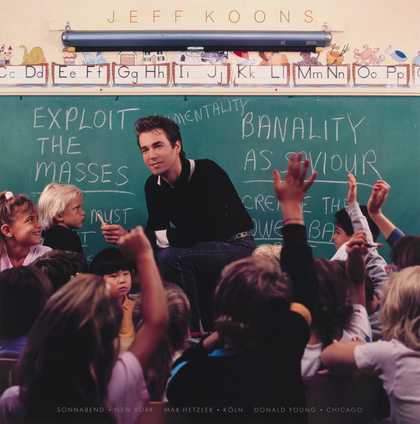
Jeff Koons
Art Magazine Ads (Art Forum) (1988–9)
ARTIST ROOMS Tate and National Galleries of Scotland
The Artforum ad shows me in front of a blackboard indoctrinating very young children – children really too vulnerable for such an indoctrination into my art. I really wanted to direct that sense of their vulnerability to the Artforum readership, the people who hate me, to make them just grit their teeth and hate me even more because I was taking their future. I was getting at their future, the youth of tomorrow.
Jeff Koons
With slogans such as ‘Exploit the Masses / Banality as Saviour’, the ads reflected Koons’s desire to ‘remove bourgeois [middle class] guilt and shame in responding to banality:
I was telling the bourgeois to embrace the thing that it likes. Don’t divorce yourself from your true being, embrace it. Don’t try to erase it because you’re in some social standing now and you’re ambitious and you’re trying to become some upper class.
Made in Heaven
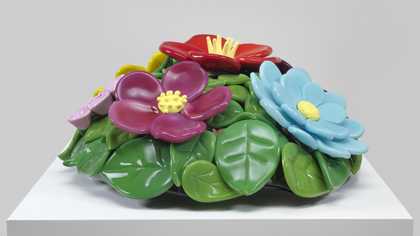
Jeff Koons
Mound of Flowers (1991)
ARTIST ROOMS Tate and National Galleries of Scotland
Made in Heaven is a series of artworks made by Koons in 1989-91. It includes paintings, and sculptures made from marble, glass and wood with subjects including flowers, animals and cherubs. The works brought together Koons's ongoing interests in desire, found objects (or readymades) and the Baroque. (The Baroque is an ornate, extravagant style of art, architecture and music that flourished in Europe in the 17th and 18th centuries.) Bourgeois Bust – Jeff and Ilona 1991 explores the theme of love. The sculpture, carved in marble, shows Jeff Koons in a tight embrace with his wife, adult film star and model Ilona Staller, also known as la Cicciolina.
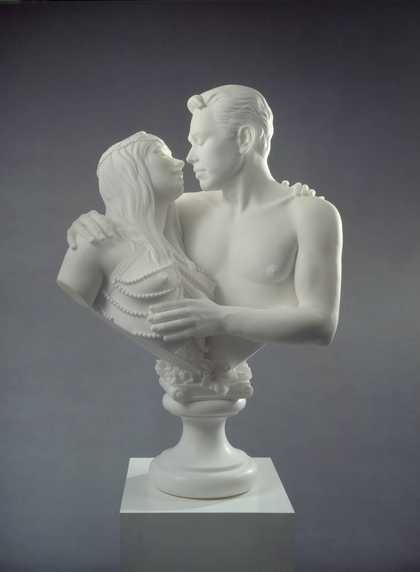
Jeff Koons
Bourgeois Bust - Jeff and Ilona (1991)
ARTIST ROOMS Tate and National Galleries of Scotland
Just married, the newly-weds gaze at each other, transfixed. Staller, with her plaited hair and string of pearls appears like Venus, the Roman goddess of love. In this series, for the first time in his career, Koons used his private life as a metaphor for ideas about the fulfilment of desires. The couple is presented in a glorified way and the title indicates their social status.
If I made it and achieved this bourgeois class, and if Ilona has, then absolutely anybody can … It might not be their desire in life to reach the bourgeois class, but I am always trying to present three–dimensional social mobility for people. That they can achieve things and move within the world
Jeff Koons
Easyfun
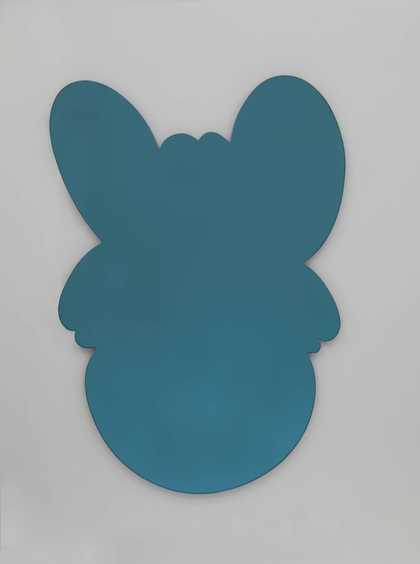
Jeff Koons
GOAT (Ice Blue) (1999)
ARTIST ROOMS Tate and National Galleries of Scotland
Art is about something that you can carry around inside yourself; it’s not about the objects – they’re just carriers of the ability to stimulate and activate the viewer’s mental and physical state.
Jeff Koons
The Easyfun series includes a series of large brightly coloured mirrors in the shape of cartoon animal heads. The mirrors are displayed together creating an installation that suggests grandeur. They are also displayed at eye level 'transforming the gallery into a child’s room.’ It is impossible to look at these giant works without seeing yourself in their polished, reflective surfaces.
Framing the viewer within a fantastical world of ponies, elephants and hippos, the artworks recall a childish way of looking at the world and a sense of self-discovery. Koons described them as ‘just as simple as a pack of Crayola’, (Crayola are a famous brand of children’s crayons). The artist selected the colours specially to complement the individual animals.
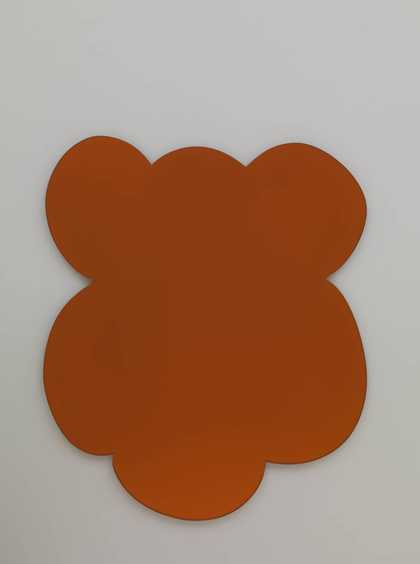
Jeff Koons
MONKEY (Red-Orange) (1999)
ARTIST ROOMS Tate and National Galleries of Scotland

Jeff Koons
WALRUS (Purple) (1999)
ARTIST ROOMS Tate and National Galleries of Scotland
The two words which form the title of the series 'easy' and 'fun' provoke the question, should fun ever be difficult or hard? Easy fun implies instant pleasure or gratification and suggests perhaps something more adult than what seems at first playful.
The mirrors also respond to our narcissistic (or self-obsessed) desire for satisfaction, fulfilling adult fantasies and pleasures. Reflection, both in mirrors or water, often symbolises Narcissus. In Greek mythology Narcissus was a very beautiful man who fell in love with his own reflection.
The Easyfun series also includes several colourful abstract paintings with cartoon-like forms that are painted in a photorealist way. (Photorealism is a style of painting that is meticulously detailed and looks like photographs.) The original source images for these paintings look like commercial images from cheap advertising; the things depicted include junk food, kitchen utensils, frozen vegetables and body parts such as lips.
What do you think? Childhood memories
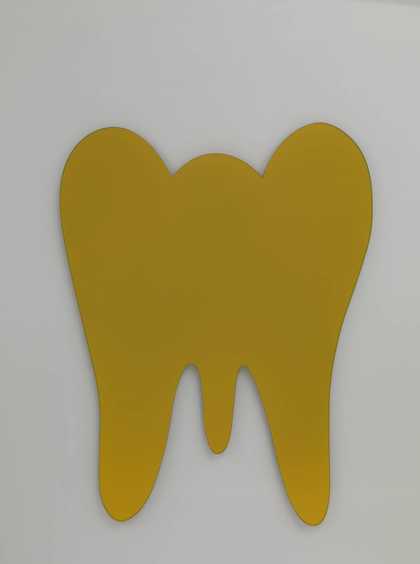
Jeff Koons
ELEPHANT (Gold) (1999)
ARTIST ROOMS Tate and National Galleries of Scotland
- Do the artworks from Jeff Koons’s Easyfun series make you think of your own childhood?
- What kind of memories and ideas do these shaped mirrors suggest?
Popeye

Jeff Koons
Caterpillar (with chains) (2002)
ARTIST ROOMS Tate and National Galleries of Scotland
One of the lines that Popeye is best known for is, 'I am what I am, and to transcend to object art, which is about the external world and other prople, you have to accept yourself first.
Jeff Koons
Caterpillar Chains 2003 is from a series of sculptures called Popeye. Popeye is a popular character in an American comic strip. The sculptures and paintings in the series focus on images and objects associated with childhood.
Caterpillar Chains looks exactly like a huge inflatable pool toy. It looks as weightless as the original toy that inspired it, and is suspended from eight bright red steel chains. But the sculpture is in fact cast in aluminium and coated in shiny, bright paint. Koons described the caterpillar, as well as the other pool toy animals in this series (which includes dolphins and lobsters), as being about ‘celebration and childhood’. He encourages his audience to find new value in this cheap everyday object.
Take a tour of Jeff Koons's studio and find out more about the materials and techniques he uses to make his extraoridnary sculptures.
The sculptures from this series are often made up of very different elements that are unsettling. The caterpillar looks weightless but is suspended from eight bright red steel chains. The chains suggest imprisonment or entrapment. Koons is perhaps hinting at something darker, such as abuse. The Popeye sculptures also seem to comment on themes relating to commerce and leisure as with the earlier Banality series. The chains could suggest that we are shackled to shopping and commodities.
Koons however says that his choice of materials and the appearance of the sculptures are about preservation. He wants to ensure that these fragile childhood objects survive. ‘The most important thing to me is the preservation of the object – the sense that it has been created to survive and that its longevity is certain.’

